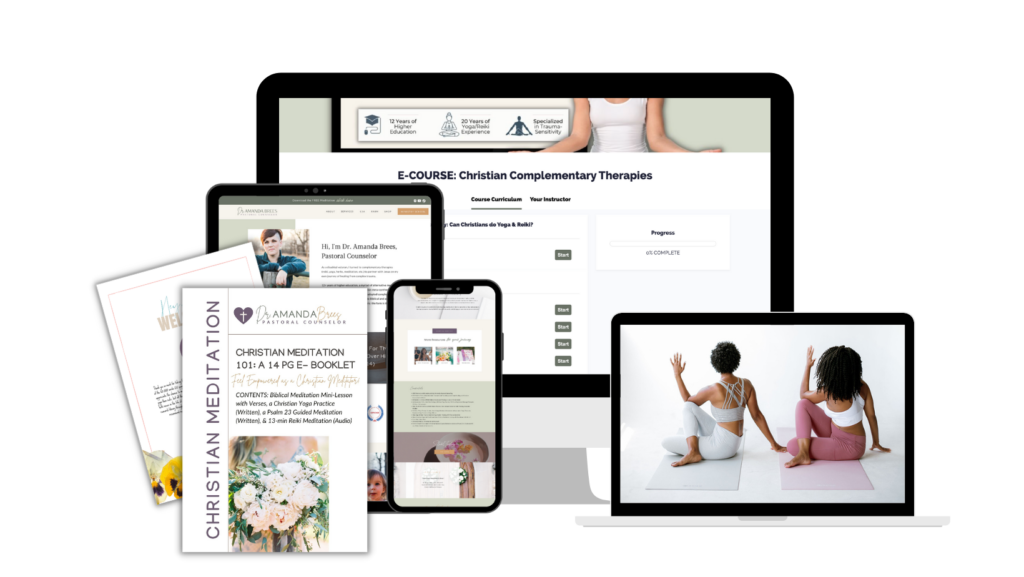CHAPTER FIVE: CONCLUSION
Summary of Findings
The study findings present preliminary support regarding the implementation of Christian-adapted complementary therapies for healing familial trauma. This support is by no means exhaustive. However, the evidence regarding the use of fourth wave treatment for trauma points toward promise for Christian-adapt mindfulness practices. Evidence suggests that additional quantitative data is needed to establish the validity of Christian-sensitive approaches that do not merely apply minor adaptions to the empirically studied methods. It appears that no irreconcilable differences exist between the mechanism of action underlying CAM and Christianity. Specifically, tools such as meditation and yoga specifically are adaptable and not the intellectual property of any religion. Instead, they appear to be adapted by many religions over thousands of years. However, there does appear to be legitimate concern regarding the Buddhist-adapted and Hindu-adapted versions of these practices popular in modern American culture. The research points to a need for Christians to need additional training and education regarding how and what needs adapting.
The primary underlying mechanism of action that is effective in catalyzing the healing of familial trauma is the surrender of human will. The modalities prove more powerful within the integration of allopathy than as stand-alone treatments. Furthermore, familial trauma does present unique challenges to adult survivors in need of spiritual answers to their unique relational problems. Another mechanism of action that is effective is the healing of attachment and relational capacity inherent in practices such as meditation. Pastoral counseling is uniquely equipped to navigate the neuroplasticity findings and contemplative neurotheology fields that necessitate a conversation of thought leaders regarding the evolution of the third and fourth waves of behavioral therapy to include additional conversations regarding spirituality in the context of Judeo-Christian culture.
Discussion
Overall, the data set did provide preliminary evidence in support of a theory of Christian-adapted complementary therapies for familial trauma. The study presented a clear description of the underlying mechanism of action, along with a general consensus regarding the need for pastors to provide more education regarding how and what needs Christian adapting. The study suggested that the efficacy for treating family trauma is existent, but certainly still in its infancy. Christian spirituality emerged as a viable solution for Christian-adapting CAM practices. The practices themselves most in question appear to be adaptable, and not inherently unredeemable. Union with God and surrender to God’s will appeared to be primary themes that catalyzed healing. Contemplative neuroscience emerged as a credible field that might support better integration of Christian methods into the third and fourth waves of behavioral therapy. The findings report that pastoral counselors are uniquely equipped to assist in this development.

God’s Attachment to Humanity
God’s ultimate act of creation was the design of the family system as a reflection of the family unit of the triune God-head, “God spoke: “Let us make human beings in our image, make them reflecting our nature” (Genesis 1:26). God made Adam, but it was not good for a man to be alone. Instead, God created an initial attachment between himself and Adam (God-attachment) that was designed to function alongside his attachment to a human family system:
God said, “It’s not good for the Man to be alone; I’ll make him a helper, a companion”
. . . God put the Man into a deep sleep. As he slept, he removed one of his ribs and replaced it with flesh. God then used the rib that he had taken from the Man to make Woman and presented her to the Man. The Man said, “Finally! Bone of my bone, flesh of my flesh! Name her Woman for she was made from Man.” Therefore, a man leaves his father and mother and embraces his wife. They become one flesh. The two of them, the Man and his Wife, were naked, but they felt no shame” (Genesis 2:18 & 23-25).
Choice is a necessary byproduct of free will. Without it, humanity would be existentially enslaved to the will of God. This lack of enslavement necessitates a redemption of the human will back into the image of God which appears to underly most contemplative practices. Love, by nature, involves the freedom to freely give or refuse it. Without the choice not to reciprocate God’s love, the love humanity gives God would be artificial. Love and will underlie the attachment of these familial attachment systems. The metanarrative of Scripture involves an avoidant attachment bond from humanity toward a securely loving God. This dynamic is exemplified in the chronic exiles of Israel—God’s chosen family who refuses to be faithful to Him. He is constantly reconciling them back to himself, yet humanity perpetually refuses God’s multitude of attempts to remain securely attached to Him. Yet, he never chooses to force them to follow the law, behave well, or love Him. Instead, the freedom of choice appears to be the very nature of the fall:
God said, “The Man has become like one of us, capable of knowing everything, ranging from good to evil. What if he now should reach out and take fruit from the Tree-of-Life and eat, and live forever? Never—this cannot happen!” So God expelled them from the Garden of Eden and sent them to work the ground, the same dirt out of which they’d been made. He threw them out of the garden and stationed angel-cherubim and a revolving sword of fire east of it, guarding the path to the Tree-of-Life” (Genesis 3:22-24).
Why is it that God allowed humanity freedom of choice? Is it because it is better to love and lose than to never love and never lose? The metanarrative of Scripture ends up back in a metaphorical cycle in a garden in the book of Revelation. Here, humanity finds itself back where it started, this time, living with a redeemed use of will in the presence of God when Jesus returns to earth to establish a new heaven and a new earth. Yet, God forces no one to live in this city. Instead, God allows humanity to make the choice to have their own way—an unredeemed will. In this reality, evil, sickness, and death reign as a result of the choices of humanity to stray from God’s will. God’s will is for heaven to reign on earth, “May your Kingdom come soon.
May your will be done on earth, as it is in heaven” (Matthew 6:10, New Living Translation). Contrary to some theological persuasions, it appears that God’s will for life on earth is how it was in heaven and in the Garden of Eden: without evil, sickness, or death. These sicknesses were a result of the fall. Hence, humanity is in desperate need of a savior. This stands in contrast to religious multiplicity and moral relativity’s delusions regarding a lack of a need for redemption of the predicament of humanity.
This familial system found initial trauma in the story of Cain and Abel (Genesis 4:8). Herein lies the first fruits of the initial betrayal of the fall. Death is contrary to God’s will. God desires for humanity to live in his presence in perfect love for eternity. Love, and attachment, were never meant to end. Death appears to be mercy that allowed man not to live in eternal suffering. The story of Noah discussed God’s first attempt to rid the earth of this evil and start fresh. Abraham was born of his descendants and God eventually gifted him, Isaac. God chose to work through this family system to remedy the initial traumas of the human condition. Isaac had Jacob and Esau who perpetuated and were victims of cycles of betrayal both within and outside of their family system. Jacob’s daughter Dinah was raped by a man named Shechem. Hurt and pain existed between Leah and Rachel, who bore Jacob’s favorite son Joseph. Joseph appeared to be a golden child as exemplified by his brother’s jealousy which resulted in them selling him off into slavery (Genesis 27:37). Joseph performed supernatural acts of dream interpretation for Pharoah while in captivity and ultimately was reunited with his beloved father many years later (Genesis 46:29). The unfolding of Joseph’s family systems is a clear picture of family systems theory applicable to pastoral counseling today.
Eventually, David became one of Israel’s greatest kings (2 Samuel 5:4), but his life was not without familial trauma. David was the black sheep of his family (1 Samuel 16:1-13). His father-in-law Saul was deeply disturbed and perpetually tried to murder David (1 Samuel 19-24). David betrayed Bathsheba’s husband by sleeping with his wife and then covering it up by taking his life (2 Samuel 11). Yet, he was also a prophetic foretelling of the reign of King Jesus and beloved by God as a man after God’s own heart (1 Samuel 13:14). His betrayal with Bathsheba eventually produced their son King Solomon. Yet, Jesus would come from David’s bloodline to bring redemption to the frailty of humanity’s broken attachment system (Matthew 1:1-17).

This story of familial trauma is the story of Jesus’ family system. Jesus was known as the son of David, the son of Abraham, and the fulfillment of the promises (2 Corinthians 1:20). Jesus is scapegoated by his own people who essentially place their sins on him and cast them out of the Jewish family system by the Pharisees as King of the Jews (John 19:21). Yet, through all of the trauma, God remains faithful to his promises by sending his own Son in the person of Jesus who is fully human and fully God (John 1:14, Colossians 2:9, John 1:1, John 10:30). As pastoral counselors, attachment theory is no longer simply an optional non-spiritual topic better left to the realm of the psychotherapist’s office. Instead, the metanarrative of Scripture is inherently the attachment failure between God and his people remedied in the life, death, and resurrection of Jesus Christ.
Roman’s road describes the evangelical understanding of how one obtains salvation.
A regeneration of will is necessary by giving one’s will back to the authority and power of Jesus in the process of salvation as listed in Roman’s road:
- “For everyone has sinned; we all fall short of God’s glorious standard”
(Romans 3:23). - “No one is righteous—not even one” (Romans 3:10).
- “When Adam sinned, sin entered the world. Adam’s sin brought death,
so death spread to everyone, for everyone sinned” (Romans 5:12). - “For the wages of sin is death, but the free gift of God is eternal life through
Christ Jesus our Lord” (Romans 6:23). - “But God showed his great love for us by sending Christ to die for us while
we were still sinners” (Romans 5:8). - “And that message is the very message about faith that we preach: If you confess
with your mouth that Jesus is Lord and believe in your heart that God raised him
from the dead, you will be saved. For it is by believing in your heart that you are made right with God, and it is by confessing with your mouth that you are saved” (Romans 10:9-10). - “So now there is no condemnation for those who belong to Christ Jesus”
(Romans 8:1).
Christian Adaptability
I found a surprising shift in the more recent literature regarding the issue of Christian adaptability. Knabb et al. (2021) have been the primary thought leaders in this regard. Originally, Garzon was a proponent of the adaptability of mindfulness for conservative Christians, but in their most recent article, they likened Christian mindfulness to Christian atheism. That said, they have established preliminary evidence for the efficacy of Christian adapted and Christian meditation techniques for clinical use.
On the one hand, that settles the issue presented in the research regarding the belief that demons are responsible for the healing present in Pentecostal and new age healing of lifeforce. On the other hand, it does appear that meditation and CAM have scientifically based healing properties not attributed to any one religion. They seem to be neutral tools like fasting and prayer. They can be adapted for each religion’s purposes the same way money can be used as a tool. Money itself is neither good nor evil on its own. It appears that the mechanism of action underlying these tools are used in the public domain instead of the intellectual property of any one’s religion, contrary to the Hindu and Buddhist origins debates.
Jain and Brown might be oversimplifying. If yoga can be adapted for religious use (to get closer to God), one is therefore exposed to many secular, Buddhist, Hindu, and Christian-adapted yoga meditations in the west. Yet, to argue that yoga is inherently Hindu and meditation is inherently Buddhist betrays their mechanism of action. Jain appears correct in that Christianity is a worldview of all tools, including CAM.
Legitimate Concerns
Brown brings legitimate awareness of the Hindu and Buddhist adapted CAM practices present in the west. This concern merits additional attention from pastors hoping to avoid religious multiplicity and moral relativity. A Christian worldview does indeed need proper adapting to be Christian-adapted in a Hindu and Buddhist-adapted culture. The study does suggest that legitimate controversy exists regarding which adaptations of meditation, yoga, and CAM Christians are receiving in the West. More attention needs to be paid to the Christian use of Hindu-adapted and Buddhist-adapted CAM practices. However, the study suggests that the nature of these spiritual tools themselves are not inherently Buddhist or Hindu and therefore redeemable by Christians.
Logical Fallacy
The study suggests that it might be an oversimplification to classify all of CAM as either entirely right or wrong for Christian use. The yogaphobic position tends to classify all of Pentecostal and charismatic healing in the mix as a gateway “drug” to opening oneself to CAM. This is an overreach likely more rooted in evangelical power struggles than critical thinking. This dynamic is similar to when the Pharisees accused Jesus of healing with demonic spirits. Jesus asked them if a kingdom could stand divided (Matthew 12:22-32). Jesus healed using power for the woman hemorrhaging that drained from his body (Matthew 9:20-22). In Luke 4:28-30, the angry mob attempts to hurl Jesus off a cliff for claiming he was the son of God. This same pharisaical Spirit seems alive and well through church history, especially when faced with what the Church deems to be heretics. That said, Christians are advised to test the spirits and test everything (1 John 4:1-6, 1 Thessalonians 4:21). The line between necessary discernment through testing spirits and pharisaical jealousy can be delicate to discern, but the line involves the intention of one’s motives. The Pharisees were often theologically correct, but Jesus was critical of the intentions of their heart (Matthew 15:8).
Pharisaical Spirit
Although it appears that legitimate concerns do exist regarding Christian use of CAM, there also appears to be another dynamic emerging whereby Christian adherents of CAM are expected to justify their choices to partake in CAM. Although this used to be the case, Martin Luther led initial protests when he nailed the 99 theses on the wall of the Catholic Church. This dynamic is similar to the desire for American culture to override the power and authority of the church to have direct access to God through this emerging wave of spiritual practices. Luther’s chief complaint was that the Catholic Church attempted to keep the Bible out of the hands of the people directly by not translating and distributing it. This dynamic led to protests, with a pendulum swing that veers toward Bible worship.
People who disagreed with the Church historically ended up crusading or excommunicated as did Luther. This Spirit of imperialism and colonization is being challenged in today’s modern society, which no longer accepts the argument of authority as grounds to stop questioning practices and theologies that are hurtful or illogical. When it comes to Christian adaptability, those with the most Bible training have sometimes misused the argument of authority to police dissenters of charismatic Christianity and CAM. Christian yogaphobics would be an example of taking a truth (CAM does need better adapting and scrutiny in the West) and overreaching with it (CAM is heresy, and I will use my authority to police those who disagree with me). This argument might be an oversimplification, but it does prove a point: Those in theological and medical power need to give better theological answers to those who advocate for the Christian use of CAM in today’s consumer-driven society (Jain, 2012). Consumers are allowed choice—something not historically possible under the Church’s reign historically. Some fundamentalist pastors take the kernel of truth inherent in practice discernment regarding the adaption of spiritual practices and take it one step further to assume that congregants cannot be trusted to read their Bible for themselves in regard to CAM practices. The study suggests a need for balance between policing other believers’ convictions about CAM while upholding Christian doctrinal integrity.
Meditation as a Science
An oversimplification would protect Christians from CAM by only allowing Christian mediation, yoga, Reiki, and acupuncture. Unfortunately, Christian tradition has been lacking and somewhat underdeveloped in some of its understanding of CAM practices. It would be wise for theologians to embrace the complexity of these nuances and subtleties in helping individuals learn how to think critically about CAM and identify areas of specific concern. Education from pastoral counselors in this regard appears to be a primary recommendation from the study.
This dynamic stands in contrast with the fundamentalist attempt to classify the entire system of CAM as satanic and demonic. With the development of contemplative neuroscience and neurotheology, it would behoove pastors to “allow” congregants access to yoga, Reiki, and meditation of all forms, similar to letting Christian children attend public school to walk out their faith. Yet, Christians need additional education regarding which adaptions of meditation or CAM they receive so they can make needed theological adjustments when necessary.

These Christians can become thought leaders in America instead of isolating themselves in already sanitized and Christianized practices. Still, the study suggests that there is room to disagree here. If conservative Christians preferred to practice already Christianized spiritual practices, it would behoove Christians to respect that choice the same way it is likewise to send children to a Christian school to foster faith values and Christian values. Regardless, it is the intention of the school that changes. Education itself is neither decidedly Christian nor non-Christian. The process of simply reading scripture and then thinking about it fails to acknowledge the complexity of the science of meditation that crosses cultures. It would be a disservice for Christians to lag in the complexities of the contemplative sciences, as the initial founders of Christian meditation were capable of adapting meditation for Christian use. Believers today appear to be capable of this same process according to the study.
It does appear that demons are not the mechanism of action that underly CAM practices per the advent of neuroimaging and neuroplasticity. CAM practices share a common interest in subtle energy and meditation that somewhat overlaps with Pentecostal spiritual healing techniques which utilize the Holy Spirit as a mechanism of action to catalyze healing. The study seems to suggest that if Christians can embrace the science which is slowly validating the efficacy of CAM, they might be more credible in distinguishing their legitimate concerns regarding the adaptability of CAM. The argument that demonic forces underly the mechanism of action inherent in CAM is not supported by the literature. Instead, it appears that the practitioner is what points a practice to or away from Christ. Meditation appears more like money in the sense that it lacks an inherent Christian distinction, yet can be utilized by Christians for a multitude of purposes and intentions. Furthermore, it would be wise for Christians to acknowledge the emerging evidence supporting the efficacy of CTs in healing as a means to better articulate their theological concerns regarding the use of the practices today. The study suggests that the argument that CAM is inherently evil fails to acknowledge the complexity of the evolution of CAM, the spiritual use of the practices in modern society, and the mechanism of action.
New Age of Christian Spirituality
The church appears to be faced with Jain’s (2012) observation that Americans are allowed to make choices that were unavailable in the past. The power differential is shifting in what appears that the new age is more of a religious freedom movement set on protesting the dogmatic and fundamentalist Judeo-Christian culture of the Church to date. Brown (2013) and others may disregard this movement as faddism or apostasy, yet their concerns regarding the adaption of the practices need to be heard. This position appears to be a common fundamentalist perspective regarding spirituality.
This study suggests that this movement is simply a response to American culture’s demand for more personal spirituality and a more direct relationship with God. The Church, stuck in its authority, has failed to answer the request from Americans for a closer relationship with God. Can the church blame congregants for wanting the more intimate experience of divine Union if the study suggests that can indeed happen with Christian theological integrity? And if so, it appears that the integration of spirituality into faith could actually be a God-ordained evolution of the Christian faith. This stands in contrast to the former stance that CAM use by Christians should be treated with the same second-class spiritual citizen condemnation associated with other commonly denounced Christian societal issues such as homosexuality and divorce.
Moreover, with the advent of the internet, one can find interfaith resources of spiritual practices from various cultures and religious traditions void of dogma and misuse of authority. That said, this influx came with a steep learning curve regarding the compatibility of the practices for Christians. The 1960s and 1970s in America marked a movement away from the argument by an authority in general. Although not without its flaws, perhaps it would behoove Christian pastoral counselors to aid pastors in rethinking this longstanding disdain toward this new age movement that historically was scapegoated or tolerated. Instead, pastoral counselors can lead the movement of educating pastors, congregants, and practitioners on the specifics of how to think critically about the practices. If more Christians were better educated regarding CAM, extremists could potentially feel alleviated of their need to police the entire landscape of Christian CAM for all Christians.
This study suggests three primary themes which emerged in this regard. The first was that pastoral counselors have a duty to educate discerning evangelicals about the mechanism of action and efficacy of CAM, the distinction of avoiding any practice that promotes worship of the self as God or moral relativity, and how to better listen to the Holy Spirit’s guidance regarding the use of CAM. In this regard, Christians have needed theological bumpers to protect themselves from straying theologically into non-Christian terrain. Yet, it gives the power back to the congregants as the priesthood of believers (1 Peter 2:5). In this regard, the role of the pastoral counselor shifts from an older version of power and authority based on fear and control, into an evolved form of spiritual authority based on trust and education. The pastoral counselors trust the congregant’s ability to think critically and understand how to use spiritual and academic authority in a less authoritarian way.
The study findings suggest it would behoove pastoral counselors to increase efforts to educate spiritual practitioners and lay ministers regarding the integration of Christian contemplative spiritual practices in the context of familial healing. The results do suggest that complex trauma that characterizes family systems trauma responds better to top-down and bottom-up practices and interventions. Pastoral counselors can educate practitioners by teaching them how to better critically think about CAM, and how to build their skills of listening to the voice of the Holy Spirit regarding the use of CAM in their practices. Tan (2011) is a primary example of how to more succinctly identify what needs Christian-adapting.
The immense frustration of fundamentalists seems to be deeper rooted in the questions as to why are congregants leaving the Church and embracing these practices in droves? Meditation and yoga have become a billion-dollar industry in America. As a result of the changing power balance, the Church is facing an identity crisis. But what if God is interested in shifting the balance of power within the church from one of power and control to trust and intimacy? What if this change is not something to be resisted, but rather a God-ordained change in how one handles disagreement, power, and authority? What if people having more access to God without having to go through the Church is the will of God?
It appears that the Church is due for and embracing another round of the reformation 500 years prior. It desires a direct experience of the divine in our daily lives, and it is willing to pursue the social justice necessary to embrace that. When one embraces this movement as a cry for spiritual maturity instead of a threat to established power and control structures, one can potentially increase their ability to speak truth into the movement (i.e., teaching yoga in public schools) and increase credibility. Our evangelism can therefore become more effective in identifying the new age movement as a needed cultural group in desperate need of shepherding and direction.
Want to learn more about Christian complementary therapies? Take the course!

References
Brees, Amanda Lynne, “The New Age of Christian Healing Ministry and Spirituality: A Meta-Synthesis Exploring the Efficacy of Christian-Adapted Complementary Therapies for Adult Survivors of Familial Trauma” (2021). Doctoral Dissertations and Projects. 3168.
https://digitalcommons.liberty.edu/doctoral/3168

+ show Comments
- Hide Comments
add a comment